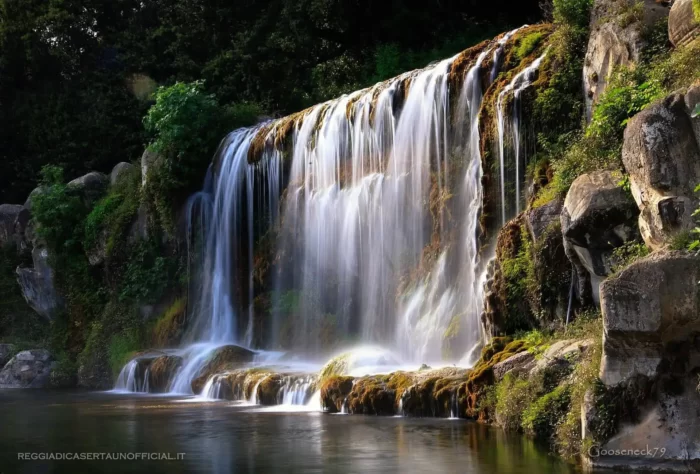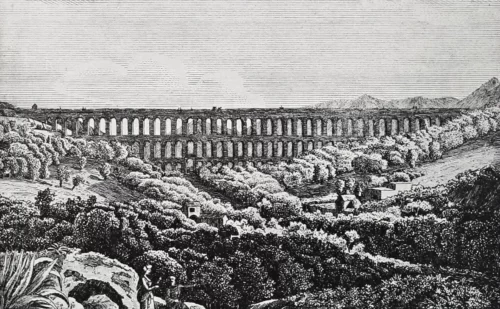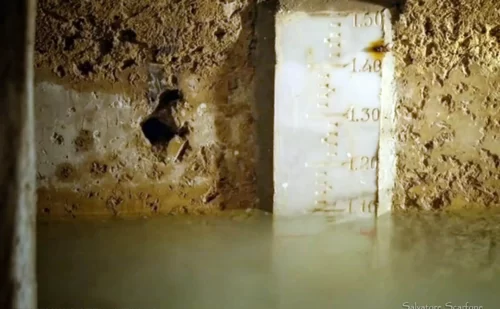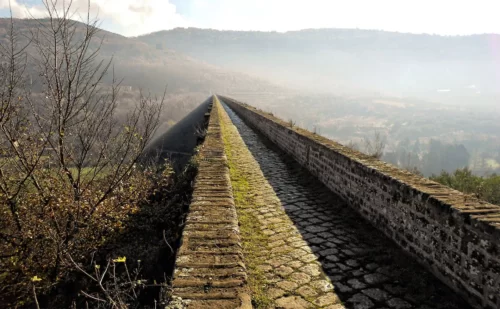The Carolino Acqueduct
The 38km of the Carolino Acqueduct was built to feed the palace, the cities of Caserta and Naples, Carditello and all the farms of the area.
The Carolino Aqueduct, 38km long, was the largest engineering work of the 18th century and the Arches of the Valley was the largest bridge of the time. With this Aqueduct Luigi Vanvitelli also surpassed the level of the ancient Roman aqueducts.
It was one of the most important public works commissioned by the Bourbons.
History of the Carolino Aqueduct
The Carolino Aqueduct, called Carolino in honor of King Charles of Bourbon, is a spectacular 38km long hydraulic engineering work built by Luigi Vanvitelli, and is certainly one of the most important public works ever built by the Bourbons.
It was immediately clear that the Carolino Aqueduct would be a work of exceptional character, not a simple work at the service of the fountains, and it is the work that better than any other expresses the close bond between Luigi Vanvitelli, the architect, and Charles of Bourbon, the commissioning king.
First of all, the aqueduct had to have a constant flow of water, and was created to supply the Palace and the fountains with water, the large and new city of Caserta which would have arisen around the palace, to improve the water supply of Naples, to supply the Royal Palace and the Carditello farm and all the mills and agricultural activities close to it. This demonstrates how much the Bourbons were a modern dynasty which, unlike other European dynasties, did not spend huge sums to build an aqueduct that had the sole purpose of feeding the fountains of the royal park, but wanted one that was also useful to the people .
Constantly informed on the progress of the works, the king personally made the inspections, also providing useful information for the search for the springs, and attended the leveling works together with the architect Luigi Vanvitelli.
The search for water sources was remarkable, and many rivers were brought together in the Carolino Aqueduct. Among other things, Vanvitelli managed to discover the position of the ancient Roman aqueduct of the Acqua Giulia, which brought water to Capua, and he inserted it perfectly into the route having dimensions identical to the Carolino, a sign of Vanvitelli’s great design mastery.
The Carolino Aqueduct was inaugurated on May 17, 1762, and was magnified throughout Europe, even becoming a destination for the Grand Tour.
The inauguration of the waterfall
“On 17 May 1762, […] there were moments of emotion in Caserta” for the inauguration of the Caroline aqueduct, designed by Luigi Vanvitelli. “At the indicated time, the whole court went to the foot of the still dry waterfall”[…] until “an enormous jet gushed from the aqueduct, gushing with a roar from the sides of the hill and poured foaming into the basins. It exploded then enthusiasm and cheers arose” (de Beauregard, 1911).
From the words of Luigi Vanvitelli:
The display of the water should be done according to the site, and will be a descent of 35 palms, into the slope of the live stone of the mountain, in length of 70 Roman palms, the width of the steps will be 19 palms, all built with wood and planks, because in the short time it is not possible for the wall construction to gain sufficient grip, so that the water would absolutely wash it away; there will be three slides and three steps 7 palms high; the slides will be rough with wood inserts, so that the water jumps and makes white foam. Although this caisson, it can be said, is so smooth due to the impotence of time, nonetheless the coating of the water will make it very smooth, and it will make a great noise due to the noise, and because it is new. (…) They will be at the 23 miles of pipeline, where the exhibition will take place; there are still 4 and a half miles left to complete the conduction.
It is interesting to note that, although it was only a temporary exhibition, the architect used the same forms that became a feature of the central axis of the Park: the waterfalls.
The ceremony was obviously a success and marked Vanvitelli’s personal affirmation over his numerous detractors138. As a reward, a thousand ducats were delivered to the architect, but paradoxically the salaries of his collaborators were reduced as the most complex part of the work had been completed.
It was Vanvitelli magnanimously who distributed a share of the reward received to each of them. In reality, the works were not yet finished and it was as late as 1768 to be able to see the water gushing from Mount Briano. After the Garzano tunnel, in fact, the aqueduct still travels a long way.
STRUCTURE
Starting from 1752, the Airola estate (BN), at the foot of Mount Taburno, at 254 meters above sea level, numerous sources were identified, all belonging to the Prince of Riccia, who donated them to the king. After the king’s approval, construction began by dividing the work into three sections:
- from Fizzo to Mount Ciesco;
- from the latter to Mount Garzano;
- from the Garzano to the royal palace.
The conduit, 1.2mX1.3m (LxH), and 38 km long, is almost entirely buried except for the bridge, which is made up of 67 pillars and arches which served both to stabilize the construction and as passageways to be used for maintenance . The works began in 1753, and were completed in 1770 with a total cost of 622,424 ducats, over €10,040,000 today. However, we must underline the fact that today the construction costs are much higher, therefore the actual expense today would be much higher.
The Arches of the Valley
The Arches of the Valley, built between 1753 and 1759, constitute the most fascinating and most admired work of the entire itinerary of the Carolino Aqueduct which recall the ancient Roman aqueducts. This bridge is 536m long and 56m high
[the water] will have to pass through a valley near Matalona, in which it will be necessary to build at least 200 palms of aqueduct, however in a small section, which must be as I express here; imagine the Civita Castellana bridge, twice as long.
The work will be Real; I will do the corresponding decorations in the great style of ancient Romans, because the work involves it and it is very honorable and conspicuous for the King and for me as well.
Among the drawings in good memory of Our Father there must be a print by Perelle of a view of the Pont du Gard in Provence, made as a water conduit joining two mountains, like the case here, with the difference that below the river will pass through it but only the road.
The memorial stones
The Ponti della Valle constitute the emblem of the Aqueduct and perform a celebratory function of the entire work. On both internal sides of the portal were placed the two inscriptions conceived by the best man of letters in Naples, the canon Alessandro Simmaco Mazzocchi, and dedicated to the sovereigns Charles of Bourbon and Maria Amalia
Towards Abruzzo
QUA MAGNO REIPUBLICAE BONO
ANNO MDCCXXXIV
CAROLUS INFANS HISPANIARUM
IN EXPEDITIONEM NEAPOLI
TANAM PROFECTIS
TRANSDUXERAT VICTOREM EXERCITUM
MOX POTITUS REGNIS UTRIUSQUE SICILIAE
REBUS PUBLICIS ORDINATIS
NON HEIC FORNICES TROPAEIS ONUSTOS
SICUT DECUISSET EREXIT
SED PER QUOS AQUAM IU
LIAM CELEBRATISSIMAM
QUAM QUONDAM IN USUM COLO
NIAE CAPUAE
AUGUSTUS CAESAR DEDUXERAT
POSTEA DISIECTAM AC DISSIPATAM
IN DOMUS AUGUSTAE OBLECTAMENTUM
SUAEQUE CAMPANIAE COMMODUM
MOLIMINE INGENTI REDUCERET
ANNO MDCCLIV
SUB CURA LUDOVICI VANVITELLI
REG. PRIM. ARCH
Towards Naples
CAROLO UTRIUSQUE SICILIAE REGE
PIO FELICE AUGUSTO
ET AMALIA REGINA
PARENTE SPEI MAXIMAE PRINCIPUM
AQUAE IULIAE REVOCANDAE OPUS
ANNO MDCCLIII INCOEPTUM
ANNO MDCCLVI CONSUMMATUM
A PONTE IPSO PER MILLIA PASSUUM XXVI
QUA RIVO SUBTERRANEO
INTERDUM ETIAM CUNICULIS
PER TRANSVERSAS E SOLIDO SA
XO RUPES ACTIS
QUA AMNE TRAIECTO
ET ARCUATIONE MULTIPLICI
SPECUBUS IN LONGITUDINEM TAN
TAM SUSPENSIS
AQUA IULIA ILLIMIS ET SALUBERRIMA
AD PRAETORIUM CASERTANUM PERDUCTA
PRINCIPUM ET POPULORUM DELI
CIIS SERVITURA
SUB CURA LUDOVICI VANVITELLI
REG. PRIM. ARCH.
External Link





















